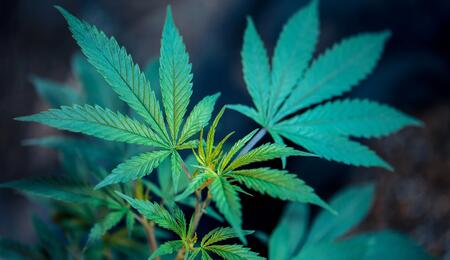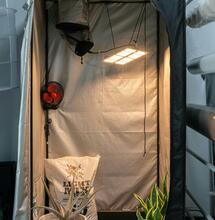How to calculate your yield

By Mr. José - info@mrjose.eu. Do you know what fishermen and growers have in common? They both have a strong tendency to exaggerate when it comes to describing their achievements. Every grower surely knows what I mean. Some of us just keep boasting how many kilos we have managed to produce under a single lamp and then share these invaluable experiences with our friends. However, the reality tends to be much soberer – not every harvest equals good yield. Let’s find out how to count your yield properly. One plant’s yield is not a very important piece of information.
How much can one plant produce?
One of the most often discussed parameters of harvest is the amount of dried female buds obtained from a single plant. However, this number does not tell you much about the real yield of your grow room. The information concerning the amount of harvested buds from a single plant, in fact, tells you more about the size of the plant than the actual yield.
Logically, a plant that gives you 15 grams must be significantly smaller than the one that gives you 50 grams. These numbers, however, do not tell you much about the time you need to grow the plants to achieve the final harvest. Instead, the weight of the total harvest from one plant can help you estimate how many flowers the grower has in the area of 1 m2. The bigger the yield from one plant, the smaller the number of plants in the growing space. It is important to note that we are now talking about indoor growing. Once you move outdoors, the yields of individual plants differ to a greater degree because of many varying factors.
A single regular plant (not autoflowering) grown outdoors can yield anything from few tens to several hundred and thousands of grams. However, we will now focus on the indoor growing. Calculating the real yield from one plant is further complicated when you attempt to compare more grow rooms with different parameters. When one grower puts four plants under one light whereas another one puts twelve plants into the same space, you can hardly evaluate their performance through yields from individual plants.
How much can you harvest in one square meter?
Another number which is often taken as an indicator of the grower’s success is one square meter. This information is way more useful. In this way, you can estimate how many grams the grower got from a specific area and easily compare the yields of several grow rooms with different parameters. It does not longer matter how many plants you are growing. Comparison that involves the size of the growroom is much easier and more accurate.
However, even with this method, you still cannot count in the time and money invested before achieving such harvest. It is important to know how long the growth phase lasted because, in this period, the lightning regime consumes more electricity than later in the flowering phase. Therefore, you need to incorporate other parameters as well.
How many grams per watt can you produce?
The more advanced growers measure their growing efficiency by comparing the strength of the lighting source and the amount of the final harvest in grams. You can quantify this factor by dividing the total weight of dried buds by power of the light source measured in watts. For example, if you harvest 450 grams of dried buds under 600W sodium lamp, you divide number 450 by 600. In this case, you would get to 0.75. That means that the efficiency of the growing is 0.75 gram per watt. A generally accepted number for a good yield is one gram per one watt.
This way, you get even closer to the numbers that somehow reflect the reality of your growing efficiency. You can clearly see that it does not matter how big your grow room is, how many plants you have in it and how much of the material you grow per square meter. Imagine a grower who can manage to grow 400 grams under the 400W lamp on one square meter whereas another one has the same harvest under the 600W lamp.
If these two guys meet and discuss their yields, it may seem that they are both similarly successful. Of course, in such case, the one who grows under the 400W lamp is the more successful one because his yield is one gram per one watt whereas the second manages to get only 0.67 of a gram per watt. [caption id="attachment_9006" align="alignnone" width="800"] Good harvest is the ultimate goal of every grower.[/caption]
Time to discuss kilowatt hours
The most precise criterion for the specification of your growing efficiency would have to include all expenses spent on one harvest and then dividing the result by the total amount of harvested grams of dried buds. Into the expenses you have to add costs of all the electricity used, costs of fertilizers, growing medium, water and wear and tear of all growing equipment used. Furthermore, you would have to add the costs of time that you spent working in the room. Still, most growers do not count all their expenses spent on growing and almost nobody counts in the time they spend in the process.
Friends who are growers usually just keep discussing the yield per meter, per plant and only occasionally think about the power of their lighting system. Despite the common belief, you can estimate most of the regular costs of your growing quite quickly – you only need to count in the costs of electricity used for lights, respectively, the time and power that you needed to grow until harvest. Let’s try an example: a grower got 400 grams of dried buds using 400W lamps.
Let’s presume that he or she kept the flowers for 10 days in the growth phase and for 60 days in the flowering phase. Our goal is now to get to the number of kilowatt-hours (kWh) of electricity he or she used. For 10 days, the grower was using the 400W lamp for 18 hours a day. 400 W equals to 0.4 kW. When you multiply this number by the number of hours during which the lamp is on in one day, you get the kWh usage. In numbers: 0.4 kW x 18 hours = 7.2 kWh. This is your electricity usage during one day of the growth phase. Ten days make it 72 kWh.
For the flowering phase, you use a similar equation: 0.4 W x 12 hours = 4.8 kWh. 4.8 kWh x 60 days = 288 kWh. 72 kWh + 288 kWh = 360 kWh. When you use this number to divide the yield of 400 grams, you get 1,1 grams per 1 kWh of the electricity consumed. With the growth phase 20 days long, the efficiency would be 0,93 grams per kWh. Now you know how to count the yield, and next time, you can dazzle your friends with your math skills and almost scientific knowledge concerning your growing efficiency.



.png)